Yes, No, Maybe So Food Choices
An At-A-Glance List
Yes Foods
Fruits
Serving size: as listed, sixty to eighty calories
Apple: one whole
Banana: one small (6-inch)
Peach: one whole
Pear: one small
Orange: one small
Grapefruit: one half
Melon (medium size): one quarter
Strawberries: five large or seven medium
Blackberries: one-half cup
Blueberries: one-half cup
Raspberries: one-half cup
Nectarine: one medium
Cherries: eleven large
Grapes: twelve
Plum: one medium
Mango: one half
Papaya: one half
Pineapple: two to three rings (one-quarter-inch thick)
Watermelon: one slice (one-inch thick)
Kiwi: one large
Prunes: five
Banana: one small (6-inch)
Peach: one whole
Pear: one small
Orange: one small
Grapefruit: one half
Melon (medium size): one quarter
Strawberries: five large or seven medium
Blackberries: one-half cup
Blueberries: one-half cup
Raspberries: one-half cup
Nectarine: one medium
Cherries: eleven large
Grapes: twelve
Plum: one medium
Mango: one half
Papaya: one half
Pineapple: two to three rings (one-quarter-inch thick)
Watermelon: one slice (one-inch thick)
Kiwi: one large
Prunes: five
Vegetables
Serving size: one-half to one cup of cooked or chopped raw vegetables will usually fall between twenty-five and sixty calories; most lettuces can be measured as several cups.
Asparagus: twelve spears
Broccoli: four to five florets
Brussels sprouts: six to eight medium
Cabbage: several cups
Onion: one medium
Artichoke: one
Cauliflower: several cups
Celery: several cups
Chicory: two to three cups
Cucumbers: unlimited
Eggplant: two cups, cubed
Carrots: two medium or ten baby
Escarole: several cups
Green beans: one and one-quarter cups or forty four-inch beans
Greens (collards, kale, mustard, turnips): one and one-half to two cups
Lettuces: several cups
Mushrooms: depends on type (see expanded list)
Okra: one and one-half to two cups
Peppers: up to several cups, cubed
Radishes: unlimited
Sprouts: several cups
Summer squash: up to several cups, cubed
Tomatoes: one medium or ten cherry
No Foods (Treats Only!)
Cookies
Cakes
Candy
Chips
Granola bars and cereals (refined)
Milk chocolate products
Many bakery goods
Crackers (fried)
Regular cut meats (any that aren’t less than 20 percent lean-cut)
Dark meat poultry with skin
White meat poultry with skin
White rice
White pasta
Cereal (sweetened, with low fiber content or minimal whole grain)
Soda
Juices (refined, not fresh-squeezed, with pulp and rind)
High-fat or high-sugar condiments
Dressings
Mayonnaise
Gravies
Canned soups
Alcoholic beverages
High-fat, high-sodium frozen foods
Whole-fat dairy products (unless child is less than two years old)
Maybe So Foods
Dairy
Low-fat or preferably fat-free.
Serving size: approximately eighty calories per serving.
Cottage cheese
Milk
Yogurt
Hard and soft cheese
Non-fat dry milk
Ricotta cheese
Low-fat soymilk and buttermilk
Meats/Poultry/Fish
Serving size: two to three ounces, children; three to four ounces, women; six ounces, men. Most of these have approximately fifty calories/ounce.
White meat skinless breast of chicken or turkey
Extra-lean (17 percent fat) meat
Low-sodium white deli meats
Fresh fish (steer clear of tilefish, shark, swordfish, king mackerel, and other high mercury fishes)
Water-packed tuna/salmon (chunk light tuna has less mercury)
Veal
Pork
Lamb without the bone
Eggs: two
Egg whites: several
“High-protein” pastas: one cup
Grains
Serving size: Since grains are served in a variety of forms use the calorie count of sixty to eighty calories per serving. For breakfast, if cereal is your main meal, you may choose a two-serving portion.
Whole grain breads (includes sourdough)
Whole grain crackers
Air-popped popcorn
Whole grain English muffin, tortilla, roll
Whole grain cereals
Brown rice/wild rice
Whole grain pasta
Beans and legumes
Serving size: one-quarter cup, rinsed, which equals one ounce of lean animal protein or about fifty calories.
All beans (red, black, kidney, broad, lima, fava, great Northern, navy, pinto, soybean)
Tofu
Nuts and seeds
Serving Size: one-quarter cup (warning: high fat content). For most varieties, a serving of ten to twenty-five nuts will equal four ounces of protein or about 160-200 calories.
Dry roasted peanuts: thirty nuts, 170 calories
Almonds: twenty-four nuts, 160 calories
Cashews: twenty nuts, 170 calories
Walnuts: fourteen nuts, 180 calories
Pecans: twenty halves, 190 calories
Macadamia nuts: eleven nuts, 200 calories
Brazil nuts: seven nuts, 170 calories
Pistachios (not jumbo): forty-seven shelled nuts, 170 calories
Seeds (includes pumpkin or sunflower): one and one-half ounces
Peanut butter (choose trans-fat-free): two level tablespoons
Starchy Vegetables
Serving size: sixty to eighty calories—these correlate to bread-like servings.
Potatoes (including sweet potatoes, though they have higher fiber content): one-half to two-thirds cup or one small
Peas: one-half cup
Corn: one small ear or one-half cup
Beets: one and one-half cups
Yucca: one-quarter cup
Pumpkin: two-thirds cup, canned, unsweetened
Rutabaga: two-thirds cup
Taro: one-half cup
Turnips: one and one-half cups
Winter squash: one cup, mashed
Yams: one-half cup, cubed
Oils
Serving size: varies, but in general one tablespoon has 120 calories, so I recommend trying to use it by the teaspoonful in individual servings of salad dressing or for cooking. Cooking sprays are another option, which you can use to coat cooking surfaces with far fewer calories.
Olive oil, nut oils, canola oil: one tablespoon equals 120 calories
Cholesterol-lowering margarines: three servings/daily are needed to achieve a health benefit, so be sure to factor in the calories. For example: Benecol® Light Spread has fifty calories /tablespoon.
Nuts, seeds and peanut butter: see the “Nuts and seeds” list
Avocado: three ounces
..................Content has been hidden....................
You can't read the all page of ebook, please click here login for view all page.
